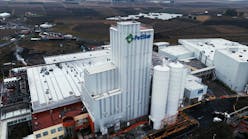Mixed Oxidant Replaces "Cocktail" of Chemicals In Power Plant Cooling Tower Water System
By Paul E. Schrock and Tom Muilenberg
A donation by NIPSCO to the Indiana Grand Kankakee Marsh Restoration Project, this 840-acre parcel that makes up the Aukiki Wetland Conservation Area is jointly owned by The Nature Conservancy and Indiana Department of Natural Resources. Protecting it and other natural areas in the region has meant strict rules for industrial water discharges, including from power plants like NIPSCO's R.M. Schahfer Generating Station in nearby Wheatfield, IN, south of Valparaiso.
NIPSCO, an electric and gas utility and subsidiary of NiSource Inc., was approached about the system during a biannual technology meeting of one of its vendors, Equip Solutions Inc. Equip Solutions is currently a Midwest representative of MIOX Corp. and also handles the majority of NIPSCO's chemical feed systems, chemical feed piping, chemical tanks, and the continuous emissions monitoring at the company's Wheatfield generating station.
MIOX, of Albuquerque, NM, has manufactured onsite disinfection generators since 1994, with more than 1,500 installations in over 30 countries treating better than 6.5 billion gallons of water a day. The NIPSCO project holds the double honor of being MIOX's first power plant cooling tower installation as well as its largest cooling tower installation.
The Schahfer Generating Station lies southeast of Chicago near Valparaiso, IN, along the Kankakee River. In the immediate area is the Aukiki Wetland Conservation Area, on land donated by NIPSCO, and nearby is the Kankakee River Swampland State Conservation Area, Kankakee State Fish and Wildlife Area, and Jasper-Pulaski Fish and Wildlife Area. As such, the station's National Pollutant Discharge Elimination System (NPDES) permit requires compliance with a chlorine residual level that cannot be exceeded when discharging into the Kankakee River's final receiving waters.
Challenge
Until spring 2010, NIPSCO's Chemical and Environmental Compliance Department had used a "tri-cocktail" regimen of sodium hypochlorite, sodium bromide, and a photosynthesis blocker (or algaecide) to treat water supplied to four cooling towers at the 1780 MW coal-fired power plant. The cooling water is allowed to reach 2-3 cycles of concentration, with the cooling tower blowdown being discharged into a 200-acre settling pond, which discharges into the Kankakee River.
Due to the NPDES permit restrictions, disinfection dosing was limited to only two hours a day for each tower. During the warm weather summer months, it was not uncommon to see spikes in Legionella above 200 colony forming units per milliliter (CFU/mL). An action level of 100 CFU/mL triggers a recommendation to workers servicing the towers to wear respiratory equipment for health safety. NIPSCO has adopted the policy of posting Legionella level warning signs at all of the cooling towers. Due to open-air hotdecks exposed to the sun on two of the towers, algae control was also an ongoing challenge.
At the time the utility first began considering a new disinfection regimen, sodium hypochlorite prices had nearly doubled to about $1.60-1.65 a gallon, so saving money was central to the idea of a new regimen. The savings potential of also reducing the number of chemicals used in bio-control from three to one only made the proposal more attractive to officials at NIPSCO, who have a forward-thinking reputation of working closely with environmental regulators to stay ahead of the regulatory curve.
NIPSCO has invested significantly in both the boiler water and cooling water areas concerning automated chemical feed control, process chemistry data acquisition, and compliance with EPRI (Electric Power Research Institute) recommended cycle chemistry guidelines. The company has also stayed ahead of the air emissions regulatory curve for NOx and SO2 removal by complying early with the Clean Air Act rules.
New System
NIPSCO installed a MIOX RIO on-site mixed oxidant disinfection system in late 2009 - early 2010 on one of the four cooling towers at R.M. Schahfer Generating Station, Unit 15, which has a flow rate of 168,000 gallons per minute (gpm). Unit 14, the tower most like Unit 15 (but with brass versus stainless steel main condenser tubes), was kept on the biocide/algaecide tri-cocktail treatment as a control comparison to help evaluate the new system's effectiveness. The hypochlorite-to-bromide biocide ratio on Unit 14 ranges from 4:1 to 8:1, depending on the tower's biological conditions. Unlike the other two towers, towers 14 and 15 have open-air hotdecks, which makes algae control more problematic.
Via an electrolytic process that generates disinfectant by passing a high amount of electrical current through a salt and water mixture, MIOX mixed oxidant systems produce a combination of chlor-oxygen species – a dilute bleach solution of 0.40% hypochlorite and related mixed oxidant compounds.
The Main Condenser Tube Sheet in Unit 15 typically needed cleaning after a long run (left--before). However, after 2 ½ months of MIOX treatment the system remained clean (right--after).
The company's RIO M5 system on Unit 15 employs an electrolytic E-cell comprised of five independent modules bolted together that can produce up to 300 lbs. per day (total) of disinfectant as free available chlorine (FAC) – which equates to 9,000 gallons per day of 0.4% mixed oxidant product. The E-cell, power supply, transformer, and system controls are fully enclosed in a high density polyethylene (HDPE) cabinet with an aluminum frame.
The mixed oxidant system operates via an Allen Bradley MicroLogix 1200 PLC control system. An internal variable speed brine pump controls the rate of the ongoing electrolytic reaction. If the E-cell ever becomes fouled, the relatively small cell volume requires minimal acid to remove calcium carbonate buildup.
The ongoing evaluation criteria for comparing Unit 15 to Unit 14 are:
- Mild steel corrosion rate data
- Dipslide total bacteria counts
- AquaFlour™ (chlorophyll A) counts
- Algae growth (and other microbially induced corrosion - MIC) on hotdecks and other cooling tower surfaces, determined by visual inspection
- Chlorine (mixed oxidant) production test, confirming that the daily ppd FAC, daily total product volume, and the 0.40% mixed oxidant solution (MOS) concentration are consistent with O&M Manual specifications over time
- Program costs/financial efficiency
- Condenser visual cleanliness
- Condenser differential pressure
- Legionella bacteria counts
Results
After two full quarters of use, the outcome has been well worth the investment, noted Bert Valenkamph, NIPSCO's Director of Chemical and Environmental Compliance.
"MIOX representatives claimed that we would see better biocontrol with this system. And I would say, based on this summer's data, that is definitely true for Legionella bacteria control," Valenkamph said. "The Unit 15 cooling water system also experienced a longer summer run without a cleaning than we have historically experienced."
Except for a brief moment at the end of September when record high temperatures promoted increased biological growth, the Unit 15 tower outperformed Unit 14. In the future, NIPSCO plans to shift the dosing regimen from an hour in the morning and an hour in the evening to four times a day in half-hour dosing periods to compensate for this during extended periods of high temperatures.
The company continues to investigate alternative dosing regimens that will yield optimal results, and has also discussed the possibility of applying for permit revisions in order to gain a longer allowable daily dosing period. Algal growth was still minimized compared to the previous years, even while tweaking the dosing strategy and volume.
As for corrosion, Steve Barnes, a NIPSCO senior chemist involved in the project, noted that the utility is currently in the process of establishing better corrosion data for the cooling water systems.
He added that "through observation and inspection, NIPSCO has not seen any negative corrosion impacts to date related to the use of the new mixed oxidant system."
Unit 15 is normally the dirtiest cooling tower and has to be cleaned regularly to clear condenser tubes. After a record long run, though, the condenser was brought down for a scheduled maintenance check in June.
"The U15 condenser was cleaner than we'd ever seen it before," Barnes said. "And there isn't any other change in the system to explain these results, other than the conversion to this new biocide system."
Financially, the system has delivered very real savings. The Unit 14 tower's treatment employs sodium hypochlorite ($65,000/year), sodium bromide ($85,000/year) and an algaecide ($75,000/year) – for a total cost of $225,000/year. Meanwhile, the MIOX-treated Unit 15 tower (with yearly forecast estimated on the high side) has annual expenses of about $34,000 in salt, $30,000 in electricity, and $2,500 in pleated 5-micron iron filters – for an approximate cost of $66,500/year. The annual savings with the system amounts to about $158,500/year. There have also been no increased costs for operating and maintaining the MIOX system compared to the previous system, even though the makeup well-water for the new system has pretreatment needs that have been very successfully addressed.
Additional savings have been realized by eliminating the man-hours for scheduling, delivery/unloading, and the separate tanks and containments required for the previous treatment regimen – not to mention the elimination of the risk and handling hazards associated with the treatment chemicals.
Conclusion
Happy with the performance and cost-saving results of using mixed oxidants, NIPSCO is in the process of evaluating other MIOX applications at the company.
"Initially, we were moving ahead from a lease standpoint, and then there was some extra capital that came up that we were able to acquire to capitalize the project at the Schahfer Generating Station," said Valenkamph. "There are other options available to us, like lease with the option to buy. And we're exploring those."
Valenkamph complimented how well MIOX, Equip Solutions, and NIPSCO worked together on this project.
"It was a very good partnership arrangement with all three companies under the direction of NIPSCO's project manager, Paul Schrock. Paul successfully implemented system engineering innovation and automation tasks needed throughout the project, resulting in optimal equipment operation and system performance. We're pleased with the results the new system has offered, especially in the Legionella and corrosion control areas. And we will continue to evaluate the data."
About the Authors: Paul Schrock is a senior chemist at the NIPSCO Valparaiso Service Center in Valparaiso, IN. He can be reached at [email protected]. Tom Muilenberg is global business director for power and heavy industry at MIOX Corp., of Albuquerque, NM. He can be reached at [email protected].
Past IWW Issues


